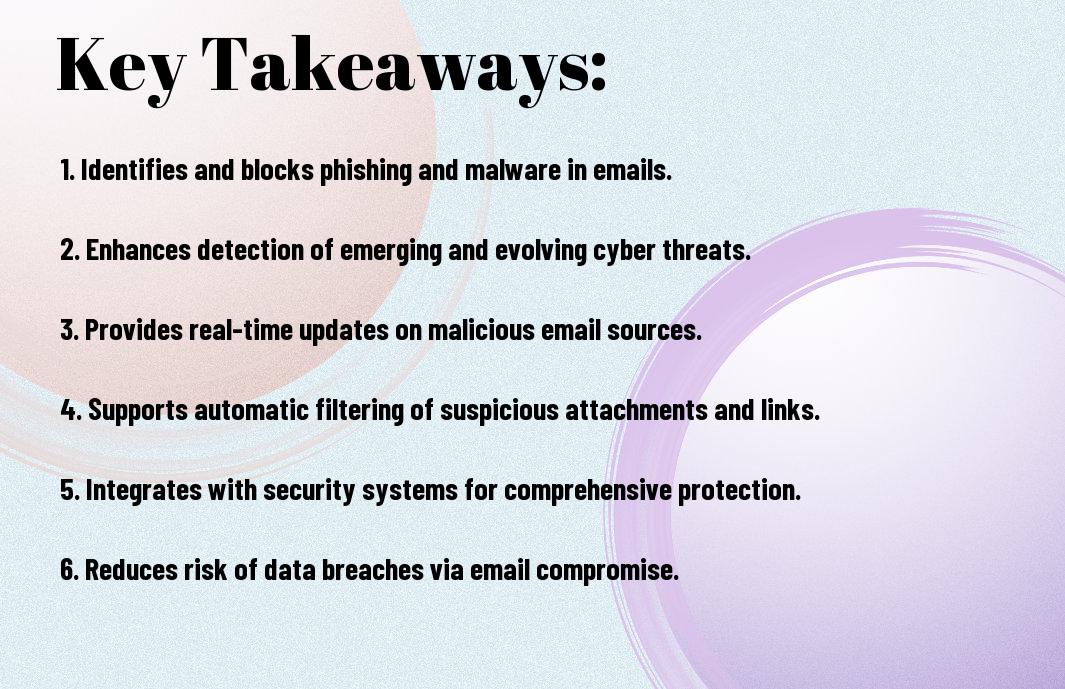Intelligence plays a vital role in enhancing the security of your email communications through secure email gateways (SEGs). By integrating threat intelligence, SEGs are equipped to recognize and neutralize potential risks before they reach your inbox. This means that you gain significant protection against phishing attacks, malware, and other cyber threats that target email as a primary vector. Understanding how threat intelligence informs your SEG can empower you to make informed decisions that strengthen your overall email security posture.
Key Takeaways:
- Threat intelligence enhances the ability of secure email gateways to identify and block phishing attempts, spam, and malware before they reach users.
- Real-time data on emerging threats allows secure email gateways to adapt their filters and detection techniques, improving overall email security posture.
- By integrating threat intelligence, organizations can prioritize alerts and responses based on the severity and relevance of the threats.
- Threat intelligence contributes to informing users about potential risks and providing guidance on safe email practices, fostering a security-aware culture.
- Automation and machine learning capabilities powered by threat intelligence streamline the response to email threats and reduce the workload on security teams.

The Integral Connection Between Threat Intelligence and Email Security
Effective email security hinges on a robust relationship with threat intelligence, which empowers secure email gateways to adapt and respond dynamically to emerging threats. By integrating real-time threat data, these gateways can not only preemptively identify malicious activities but also learn from evolving tactics used by cybercriminals. With a comprehensive understanding of the threat landscape, you enhance your organization’s ability to maintain secure communication channels and protect sensitive information from unauthorized access.
Defining Threat Intelligence in the Email Context
In the context of email security, threat intelligence refers to actionable information about existing or emerging threats that can compromise email systems. This encompasses knowledge about phishing schemes, malware signatures, and patterns of suspicious behavior. Leveraging threat intelligence allows secure email gateways to use comprehensive data for improved filtering and detection mechanisms, thereby reducing risks associated with email transmission.
The Interplay Between Cyber Threats and Email Usage
Email remains a primary vector for cyber threats, with statistics showing that nearly 90% of all data breaches involve email. Cybercriminals exploit the trust inherent in electronic communication, utilizing tactics such as impersonation, attachments containing malware, and links to phishing sites. As users increasingly rely on email for both personal and business transactions, the attack surface expands, necessitating a proactive approach to threat intelligence to mitigate risks effectively.
The dynamic relationship between cyber threats and email usage highlights the urgency for organizations to remain vigilant and informed. Each email sent or received can potentially expose you to risks, as attackers constantly evolve their tactics to evade detection. For example, spear phishing attacks target specific individuals within a company, making them difficult to identify without effective threat intelligence. By staying ahead of these threats with timely updates and intelligence feeds, you can better secure your email communications and reduce vulnerability in your networks.

Enhancing Email Gateway Protection with Threat Intelligence
Integrating threat intelligence into your secure email gateway significantly enhances its protective capabilities. By leveraging data about existing and emerging threats, your email defense mechanisms can be fine-tuned to identify and neutralize potential attacks. This proactive approach not only shields your organization from known vulnerabilities but also adjusts to the shifting landscape of cyber threats, ensuring a more robust security posture.
Real-Time Threat Analysis and Response
With the help of threat intelligence, your secure email gateway can perform real-time threat analysis, allowing immediate response to emerging threats. This capability enables your system to assess emails, attachments, and links against continually updated threat databases, helping you spot phishing attempts or malware-laden communications before they can inflict damage.
Proactive Vulnerability Identification
Proactive vulnerability identification transforms your email security from a reactive to a forward-thinking strategy. By analyzing historical threat data and current attack patterns, your email gateway can spot potential weaknesses within your organization’s email infrastructure. This foresight allows for timely updates and adjustments to existing security measures.
As cyber threats continue to evolve, staying ahead of potential vulnerabilities becomes imperative for your organization. Threat intelligence empowers you to scrutinize trends in cyberattacks, enabling your secure email gateway to adapt and harden defenses against specific tactics employed by cybercriminals. By continuously monitoring these trends, you can implement targeted protections such as updated filtering rules or enhanced authentication measures, effectively diminishing your risk exposure and reinforcing your email safety protocols.
The Role of Automation in Threat Intelligence
Automation plays a vital role in integrating threat intelligence into your secure email gateway, allowing for rapid responses to evolving threats. By automating the analysis and processing of threat data, you significantly reduce the time taken to identify potential risks. This proactive approach not only enhances your security posture but also ensures that your teams can focus on higher-level strategic tasks rather than getting bogged down in routine threat assessments.
Streamlining Threat Detection Processes
By leveraging automation, you streamline the threat detection processes inherent in your email security system. This capability enables your secure email gateway to automatically correlate threat data with incoming emails, allowing for real-time identification of suspicious content or malicious attachments. The efficiency of automation means that potential threats can be neutralized before they reach the end user, significantly reducing the likelihood of breaches or data loss.
The Importance of Machine Learning in Email Security
Machine learning enhances your email security by utilizing algorithms that analyze vast amounts of email data to pinpoint malicious activities. This technology continuously improves itself, learning from each attempt and refining its detection capabilities. For example, machine learning can identify subtle patterns in phishing attempts that traditional methods might overlook, increasing your email gateway’s effectiveness against sophisticated threats.
With machine learning, your secure email gateway can adapt to new and evolving threats by analyzing not just the content of emails, but also user behavior, sending patterns, and even the context surrounding communications. These systems can detect anomalies that suggest malicious intent, allowing for a proactive defense. According to recent reports, organizations that implemented machine learning in their email security saw a reduction in phishing incidents by up to 70%. As threats become more advanced, integrating machine learning is not just beneficial; it’s vital for maintaining effective email security.
Evaluating the Efficacy of Threat Intelligence in Email Gateways
Assessing the impact of threat intelligence within your email gateway requires a focused approach. You’ll want to analyze both the frequency of detected threats and how effectively they were mitigated. Tracking incidents over time can reveal patterns in attacks, allowing you to gauge whether the intelligence is enhancing your detection and response capabilities. Compiling data from threat feeds, alerts, and user feedback will provide a clearer picture of performance, enabling you to make informed adjustments and improvements.
Metrics to Measure Success and Improvement
Key performance indicators (KPIs) such as the reduction in phishing attempts, response time to alerts, and false positive rates serve as vital metrics in evaluating the success of threat intelligence integration. Establishing benchmarks helps you quantify improvements over time and understand which aspects of your email security strategy require further attention. Regular reviews of these metrics will keep your SECURE email gateway aligned with ongoing threat landscapes.
Integrating Threat Intel with Overall Security Posture
To fortify your overall security posture, embedding threat intelligence into broader IT initiatives is imperative. Engaging with cross-functional teams allows for a holistic view of risks, where your email security strategies can benefit from insights shared between departments, including network security and endpoint protection. This collaboration ensures that intelligence gained from monitoring email gateways informs policies across the organization, streamlining responses to threats and bolstering defenses. By aligning your threat intelligence with overall security measures, you empower your entire infrastructure to proactively counter diverse cyber threats.

Future Trends: The Evolution of Threat Intelligence in Email Security
The future of threat intelligence in email security will see a profound transformation as cyber threats become increasingly sophisticated. Advancements in automated machine learning and artificial intelligence will empower secure email gateways to predict and respond to threats in real-time. This evolution will not only result in more accurate threat detection but also facilitate proactive measures, allowing organizations to stay one step ahead of potential attacks while maintaining user trust and data integrity.
The Impact of Emerging Technologies on Threat Detection
Emerging technologies, such as artificial intelligence and machine learning, will significantly enhance threat detection capabilities within email security systems. These advancements allow for deeper analysis of email patterns, improving the identification of anomalies that could signal potential threats. By leveraging vast datasets and adaptive algorithms, your email security posture will continuously improve, ensuring that threats are understood and neutralized swiftly.
Preparing for Future Email Threat Landscapes
To effectively prepare for future email threat landscapes, you must adopt a proactive and adaptive strategy that prioritizes continuous monitoring and evaluation. This involves implementing real-time threat intelligence feeds that provide instant updates on emerging threats and attack vectors. Regular training of employees on recognizing phishing attempts and other cyber threats also plays a key role. Investing in advanced security frameworks alongside integrating collaborative threat intelligence can position your organization to swiftly adapt and counteract evolving cyber risks.
To wrap up
With this in mind, understanding the role of threat intelligence in your secure email gateway is vital for enhancing your cybersecurity posture. It helps you identify and respond to emerging threats, ensuring that your email communications remain safe and reliable. By leveraging threat intelligence, you can make informed decisions to protect your organization from potential risks. For an in-depth look at how to implement these strategies effectively, check out this article on Secure Email Gateway: Essential Protection for Modern ….
FAQ
Q: What is threat intelligence in the context of a secure email gateway?
A: Threat intelligence refers to the information and insights gathered regarding potential threats to an organization’s email systems. In the context of a secure email gateway, it encompasses data about known threats such as spam, phishing attacks, malware, and other malicious activities. This information is used to enhance the security measures of the email gateway by allowing it to recognize and block payloads that might compromise the system.
Q: How does threat intelligence improve the detection of email-based attacks?
A: Threat intelligence enhances the detection capabilities of secure email gateways by providing real-time data on emerging threats and tactics used by cybercriminals. By utilizing threat intelligence feeds, email gateways can identify patterns and signatures associated with malicious content, enabling them to filter out suspicious emails more effectively. This proactive approach aids in preventing attacks before they reach the user’s inbox.
Q: Can threat intelligence reduce false positives in email filtering?
A: Yes, threat intelligence can significantly reduce false positives by refining the criteria used for filtering emails. By incorporating context about known threats and user behavior patterns, a secure email gateway can better differentiate between legitimate communications and potential threats. This results in a more accurate filtering process, allowing imperative emails to pass through while still maintaining high security against actual threats.
Q: What types of threat intelligence should organizations integrate into their secure email gateways?
A: Organizations should integrate various types of threat intelligence that include tactical, operational, and strategic data. Tactical intelligence focuses on indicators of compromise (IoCs), such as malware signatures and malicious URLs. Operational intelligence provides insights into threat actors and their capabilities, while strategic intelligence includes information about broader trends in cyber threats and how they may impact an organization’s email security. Utilizing a combination of these types can significantly strengthen email protection.
Q: How does threat intelligence keep pace with evolving email threats?
A: Threat intelligence keeps pace with evolving email threats by leveraging machine learning and automation. Secure email gateways can utilize advanced algorithms that analyze vast amounts of data to identify new threats in real-time. Additionally, threat intelligence providers frequently update their databases with fresh data on newfound tactics, techniques, and procedures (TTPs), allowing secure email gateways to adapt and respond swiftly to new types of attacks. This continual evolution is imperative for maintaining effective email security.

